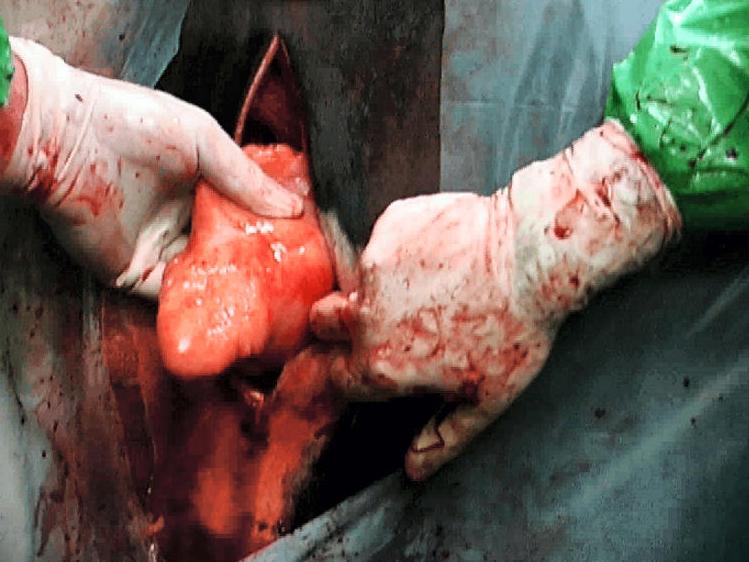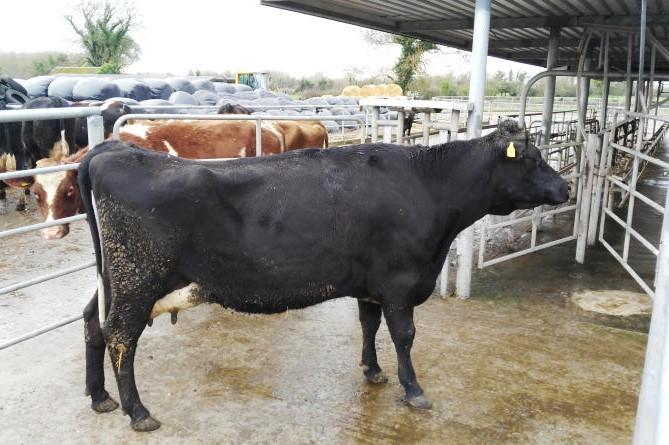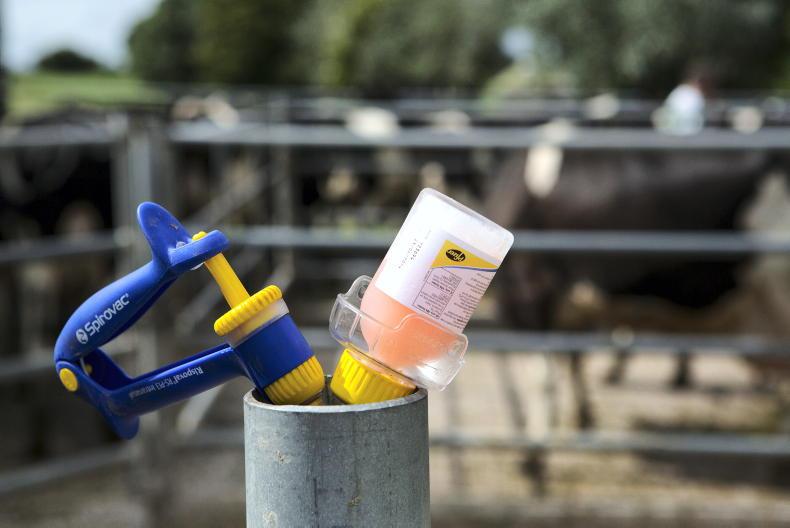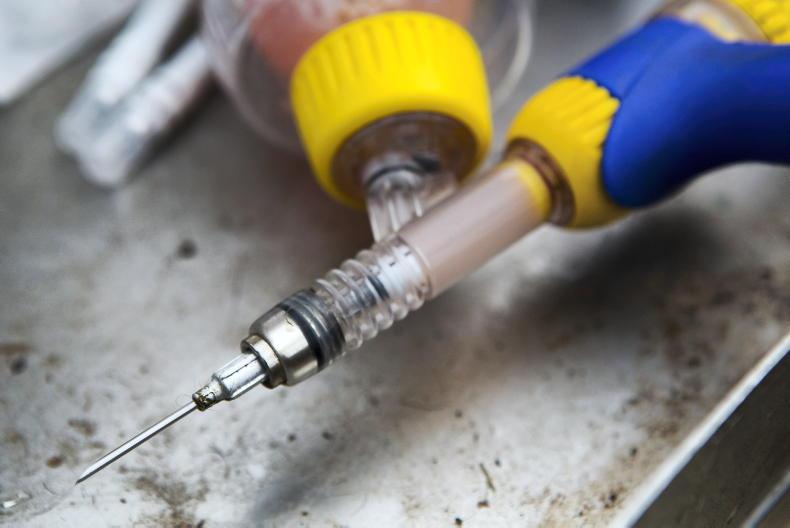Having a calf is the biggest event in a cow’s life. It puts her at enormous risk of contracting sickness and disease, even though it is part of her species’ natural evolution to reproduce. Dairy farming is essentially managing the reproduction of dairy cows and harvesting the milk that is produced. This article will discuss two common issues facing freshly calved cows – retained cleanings and displaced abomasums.
Retained cleanings
The cleaning, or the placenta to give it its proper name, is what connects the unborn calf to the cow.

The best place for a placenta - out of the cow.
The cleaning connects the calf’s naval to the wall of the womb through hundreds of cotyledons, which passes oxygen and nutrients from the cow to the calf.
These cotyledons are like snap-on buttons on a shirt. Normally, the cotyledons detach themselves from the womb between two and eight hours after calving and the cleaning pops out. When the cleaning doesn’t emerge within 12 hours, it is considered to be a retained cleaning, as some of the cotyledons did not detach.
Retained cleanings are a side effect of other issues
There is a higher likelihood of retained cleanings in cows that have had hard calvings, twins, milk fever or a mineral deficiency.
If the cow has been challenged, there’s a greater likelihood that she’ll retain the cleaning. It’s hard to know what incidence rates of retained cleanings are in Ireland.
Retained cleanings are a side effect of other issues, so if you’ve got a lot of hard calvings, milk fever or twins, then you’re bound to have more of them.
A retained cleaning by itself tends not to cause a problem, but it can lead to serious health issues. A hanging cleaning, while unsightly, also leaves the cow open to infection. Because the cleaning is in contact with the outside world, it offers a bridge for bacteria to enter the womb.
After a hard calving or having twins, the muscles around the womb can be worn out and don’t have enough energy or power to snap off the cotyledons and push out the cleaning
The other major problem is that over time, the cleaning will naturally degrade and as it does it can become toxic, causing illness.
Retained cleanings are nearly always due to a lack of muscle power in the womb.
After a hard calving or having twins, the muscles around the womb can be worn out and don’t have enough energy or power to snap off the cotyledons and push out the cleaning.
A mineral or vitamin deficiency, such as milk fever (brought on by a lack of calcium), or a magnesium, selenium or vitamin E deficiency also reduce the muscle power of the womb – leading to slower calvings and retained cleanings.
When faced with a problem, the first thing to do is to identify the cause. Unless good records of births on the farm are maintained, it won’t be known if a retained cleaning is caused by a hard calving or an underlying nutritional problem.
Cure
Dealing with retained cleanings is difficult, as it affects each cow differently. Some cows get sick a day or two after calving, while others can have a retained cleaning for over a week and remain outwardly healthy.
The temptation is always to pull the cleaning out, but this is not advised, especially not in the first five days after calving.
The big risk with pulling out the cleaning is that damage could be done to the womb, as the wall of the womb on which the cleaning is attached is already weakened and harm may be done.
Sometimes, a light pull on the cleaning four or five days after calving is sufficient for all the cleaning to come out
Secondly, there is a high risk of the cleaning splitting, with the part of the cleaning left in the womb more likely to remain there, turn toxic and lead to further problems.
Sometimes, a light pull on the cleaning four or five days after calving is sufficient for all the cleaning to come out, especially if the cow exerts some internal force.
The majority of cows that have retained cleanings also have some degree of metritis, or womb infections.
The degree of metritis can vary, but in acute cases, there is a foul-smelling brown watery discharge from the uterus, a high temperature and the cow will be visibly sick and off her feed.
They will likely insert a Metricure or other antibiotic into the womb and possibly put the cow on a course of antibiotics too
In such cases, the vet should be called.
They will likely insert a Metricure or other antibiotic into the womb and possibly put the cow on a course of antibiotics too. A number of washouts a couple of days apart may be needed before the womb cleans.
Stomach displacement
A displaced abomasum is when the abomasum (one of the four stomachs of the cow) twists and gets displaced, either to the right or to the left of the main stomach compartments. Left displaced abomasum (LDA) tends to be more common than right displaced abomasum (RDA). It’s difficult to know national incidence rates, but it’s more common on some farms than others, which seems to suggest that the condition can be prevented.

A vet operating on a displaced abomasum. The operation is similar to a caesarean section.
A displaced abomasum is a serious condition. The cow will be off her feed and back in milk yield. If left untreated, the cow will more than likely pine away. Early intervention is key and the best way of achieving that is to know the signs of a displaced abomasum (DA).
While a vet is required for an accurate diagnosis (usually determined by a pinging sound coming from the abomasum), what the farmer needs to do is identify the off-form cow. The best way of doing this is to check that cows have eaten all their meal in the parlour.
Cows that have a DA will more than likely be off their feed, especially high-starch concentrate feeds.
Another good way to examine the health of cows is to watch them after they return to the field (or to the shed) after milking.
A cow with a DA will be sullen and usually only nibbles at grass
Most cows will graze vigorously when they get a fresh break of grass.
A cow with a DA will be sullen and usually only nibbles at grass. It’s the same for cows in a shed. When fresh feed is offered, cows should all rise and show interest in eating. The sick cow will more than likely be lying down.
These descriptions indicate that the cow is sick and that the vet should be called to investigate further.
If a DA is diagnosed, the decision has to be made whether to operate or not. There are some non-surgical methods of treating a DA, such as rolling the cow, giving her coffee, or bringing the cow for a spin in the cow box.
However, in my opinion, surgery performed by an experienced vet is the most effective. Recovery is usually quick once the issue has been diagnosed.
Despite some commonly held misconceptions, there is no evidence to say that early spring-grazing contributes to a higher incidence of DA
The causes of a displaced abomasum are not fully known.
Like a lot of conditions, there are multiple factors involved, including diet, mineral status and genetics. Despite some commonly held misconceptions, there is no evidence to say that early spring-grazing contributes to a higher incidence of DA.
Retained cleanings pose a risk to the uterine health of the cow. Retained cleanings usually occur after another event, such as a hard calving, twins, milk fever, etc.Interfering with a cleaning too soon can cause more problems. A light pull after five days is usually sufficient. Watch for signs of cows off form as this could indicate a cow with a displaced abomasum. A vet will be required to diagnose and operate on a displaced abomasum. Read more
Watch: stop-start grazing in north Offaly
Milk price continues upward trend
Having a calf is the biggest event in a cow’s life. It puts her at enormous risk of contracting sickness and disease, even though it is part of her species’ natural evolution to reproduce. Dairy farming is essentially managing the reproduction of dairy cows and harvesting the milk that is produced. This article will discuss two common issues facing freshly calved cows – retained cleanings and displaced abomasums.
Retained cleanings
The cleaning, or the placenta to give it its proper name, is what connects the unborn calf to the cow.

The best place for a placenta - out of the cow.
The cleaning connects the calf’s naval to the wall of the womb through hundreds of cotyledons, which passes oxygen and nutrients from the cow to the calf.
These cotyledons are like snap-on buttons on a shirt. Normally, the cotyledons detach themselves from the womb between two and eight hours after calving and the cleaning pops out. When the cleaning doesn’t emerge within 12 hours, it is considered to be a retained cleaning, as some of the cotyledons did not detach.
Retained cleanings are a side effect of other issues
There is a higher likelihood of retained cleanings in cows that have had hard calvings, twins, milk fever or a mineral deficiency.
If the cow has been challenged, there’s a greater likelihood that she’ll retain the cleaning. It’s hard to know what incidence rates of retained cleanings are in Ireland.
Retained cleanings are a side effect of other issues, so if you’ve got a lot of hard calvings, milk fever or twins, then you’re bound to have more of them.
A retained cleaning by itself tends not to cause a problem, but it can lead to serious health issues. A hanging cleaning, while unsightly, also leaves the cow open to infection. Because the cleaning is in contact with the outside world, it offers a bridge for bacteria to enter the womb.
After a hard calving or having twins, the muscles around the womb can be worn out and don’t have enough energy or power to snap off the cotyledons and push out the cleaning
The other major problem is that over time, the cleaning will naturally degrade and as it does it can become toxic, causing illness.
Retained cleanings are nearly always due to a lack of muscle power in the womb.
After a hard calving or having twins, the muscles around the womb can be worn out and don’t have enough energy or power to snap off the cotyledons and push out the cleaning.
A mineral or vitamin deficiency, such as milk fever (brought on by a lack of calcium), or a magnesium, selenium or vitamin E deficiency also reduce the muscle power of the womb – leading to slower calvings and retained cleanings.
When faced with a problem, the first thing to do is to identify the cause. Unless good records of births on the farm are maintained, it won’t be known if a retained cleaning is caused by a hard calving or an underlying nutritional problem.
Cure
Dealing with retained cleanings is difficult, as it affects each cow differently. Some cows get sick a day or two after calving, while others can have a retained cleaning for over a week and remain outwardly healthy.
The temptation is always to pull the cleaning out, but this is not advised, especially not in the first five days after calving.
The big risk with pulling out the cleaning is that damage could be done to the womb, as the wall of the womb on which the cleaning is attached is already weakened and harm may be done.
Sometimes, a light pull on the cleaning four or five days after calving is sufficient for all the cleaning to come out
Secondly, there is a high risk of the cleaning splitting, with the part of the cleaning left in the womb more likely to remain there, turn toxic and lead to further problems.
Sometimes, a light pull on the cleaning four or five days after calving is sufficient for all the cleaning to come out, especially if the cow exerts some internal force.
The majority of cows that have retained cleanings also have some degree of metritis, or womb infections.
The degree of metritis can vary, but in acute cases, there is a foul-smelling brown watery discharge from the uterus, a high temperature and the cow will be visibly sick and off her feed.
They will likely insert a Metricure or other antibiotic into the womb and possibly put the cow on a course of antibiotics too
In such cases, the vet should be called.
They will likely insert a Metricure or other antibiotic into the womb and possibly put the cow on a course of antibiotics too. A number of washouts a couple of days apart may be needed before the womb cleans.
Stomach displacement
A displaced abomasum is when the abomasum (one of the four stomachs of the cow) twists and gets displaced, either to the right or to the left of the main stomach compartments. Left displaced abomasum (LDA) tends to be more common than right displaced abomasum (RDA). It’s difficult to know national incidence rates, but it’s more common on some farms than others, which seems to suggest that the condition can be prevented.

A vet operating on a displaced abomasum. The operation is similar to a caesarean section.
A displaced abomasum is a serious condition. The cow will be off her feed and back in milk yield. If left untreated, the cow will more than likely pine away. Early intervention is key and the best way of achieving that is to know the signs of a displaced abomasum (DA).
While a vet is required for an accurate diagnosis (usually determined by a pinging sound coming from the abomasum), what the farmer needs to do is identify the off-form cow. The best way of doing this is to check that cows have eaten all their meal in the parlour.
Cows that have a DA will more than likely be off their feed, especially high-starch concentrate feeds.
Another good way to examine the health of cows is to watch them after they return to the field (or to the shed) after milking.
A cow with a DA will be sullen and usually only nibbles at grass
Most cows will graze vigorously when they get a fresh break of grass.
A cow with a DA will be sullen and usually only nibbles at grass. It’s the same for cows in a shed. When fresh feed is offered, cows should all rise and show interest in eating. The sick cow will more than likely be lying down.
These descriptions indicate that the cow is sick and that the vet should be called to investigate further.
If a DA is diagnosed, the decision has to be made whether to operate or not. There are some non-surgical methods of treating a DA, such as rolling the cow, giving her coffee, or bringing the cow for a spin in the cow box.
However, in my opinion, surgery performed by an experienced vet is the most effective. Recovery is usually quick once the issue has been diagnosed.
Despite some commonly held misconceptions, there is no evidence to say that early spring-grazing contributes to a higher incidence of DA
The causes of a displaced abomasum are not fully known.
Like a lot of conditions, there are multiple factors involved, including diet, mineral status and genetics. Despite some commonly held misconceptions, there is no evidence to say that early spring-grazing contributes to a higher incidence of DA.
Retained cleanings pose a risk to the uterine health of the cow. Retained cleanings usually occur after another event, such as a hard calving, twins, milk fever, etc.Interfering with a cleaning too soon can cause more problems. A light pull after five days is usually sufficient. Watch for signs of cows off form as this could indicate a cow with a displaced abomasum. A vet will be required to diagnose and operate on a displaced abomasum. Read more
Watch: stop-start grazing in north Offaly
Milk price continues upward trend











SHARING OPTIONS